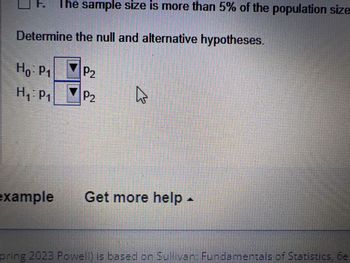In randomized, double-blind clinical trials of a new vaccine, rats were randomly divided into two groups. Subjects in group 1 received the new vaccine while subjects in group 2 received a control vaccine. After the second dose, 107 of 676 subjects in the experimental group (group 1) experienced fever as a side effect. After the second dose, 64 of 557 of the subjects in the control group (group 2) experienced fever as a side effect. Does the evidence suggest that a higher proportion of subjects in group 1 experienced fever as a side effect than subjects in group 2 at the a= 0.10 level of significance? Verify the model requirements. Select all that apply. A. The samples are dependent. B. The samples are independent. C. The data come from a population that is normally distributed. D. The sample size is less than 5% of the population size for each sample. E. ₁₁ (1-₁) ≥ 10 and n₂P₂ (1-₂) ²10 OF. The sample size is more than 5% of the population size for each sample.
In randomized, double-blind clinical trials of a new vaccine, rats were randomly divided into two groups. Subjects in group 1 received the new vaccine while subjects in group 2 received a control vaccine. After the second dose, 107 of 676 subjects in the experimental group (group 1) experienced fever as a side effect. After the second dose, 64 of 557 of the subjects in the control group (group 2) experienced fever as a side effect. Does the evidence suggest that a higher proportion of subjects in group 1 experienced fever as a side effect than subjects in group 2 at the a= 0.10 level of significance? Verify the model requirements. Select all that apply. A. The samples are dependent. B. The samples are independent. C. The data come from a population that is normally distributed. D. The sample size is less than 5% of the population size for each sample. E. ₁₁ (1-₁) ≥ 10 and n₂P₂ (1-₂) ²10 OF. The sample size is more than 5% of the population size for each sample.
MATLAB: An Introduction with Applications
6th Edition
ISBN:9781119256830
Author:Amos Gilat
Publisher:Amos Gilat
Chapter1: Starting With Matlab
Section: Chapter Questions
Problem 1P
Related questions
Question

Transcribed Image Text:In randomized, double-blind clinical trials of a new vaccine, rats were randomly divided into two groups. Subjects in
group 1 received the new vaccine while subjects in group 2 received a control vaccine. After the second dose, 107 of
676 subjects in the experimental group (group 1) experienced fever as a side effect. After the second dose, 64 of 557
of the subjects in the control group (group 2) experienced fever as a side effect. Does the evidence suggest that a
higher proportion of subjects in group 1 experienced fever as a side effect than subjects in group 2 at the a=0.10
level of significance?
Verify the model requirements. Select all that apply.
A. The samples are dependent.
B. The samples are independent.
C. The data come from a population that is normally distributed.
D. The sample size is less than 5% of the population size for each sample.
□ E. n₁₁ (1-₁) ≥ 10 and n₂P₂ (1-P₂) ² 10
F. The sample size is more than 5% of the population size for each sample.
Expert Solution
This question has been solved!
Explore an expertly crafted, step-by-step solution for a thorough understanding of key concepts.
Step by step
Solved in 3 steps

Follow-up Questions
Read through expert solutions to related follow-up questions below.
Follow-up Question

Transcribed Image Text:Determine the null and alternative hypotheses.
7 P₂
Ho: P₁
H₁: P₁
The sample size is more than 5% of the population size
example
N
P₂
A
Get more help -
pring 2023 Powell) is based on Sullivan: Fundamentals of Statistics, 6e
Solution
Recommended textbooks for you

MATLAB: An Introduction with Applications
Statistics
ISBN:
9781119256830
Author:
Amos Gilat
Publisher:
John Wiley & Sons Inc

Probability and Statistics for Engineering and th…
Statistics
ISBN:
9781305251809
Author:
Jay L. Devore
Publisher:
Cengage Learning

Statistics for The Behavioral Sciences (MindTap C…
Statistics
ISBN:
9781305504912
Author:
Frederick J Gravetter, Larry B. Wallnau
Publisher:
Cengage Learning

MATLAB: An Introduction with Applications
Statistics
ISBN:
9781119256830
Author:
Amos Gilat
Publisher:
John Wiley & Sons Inc

Probability and Statistics for Engineering and th…
Statistics
ISBN:
9781305251809
Author:
Jay L. Devore
Publisher:
Cengage Learning

Statistics for The Behavioral Sciences (MindTap C…
Statistics
ISBN:
9781305504912
Author:
Frederick J Gravetter, Larry B. Wallnau
Publisher:
Cengage Learning

Elementary Statistics: Picturing the World (7th E…
Statistics
ISBN:
9780134683416
Author:
Ron Larson, Betsy Farber
Publisher:
PEARSON

The Basic Practice of Statistics
Statistics
ISBN:
9781319042578
Author:
David S. Moore, William I. Notz, Michael A. Fligner
Publisher:
W. H. Freeman

Introduction to the Practice of Statistics
Statistics
ISBN:
9781319013387
Author:
David S. Moore, George P. McCabe, Bruce A. Craig
Publisher:
W. H. Freeman